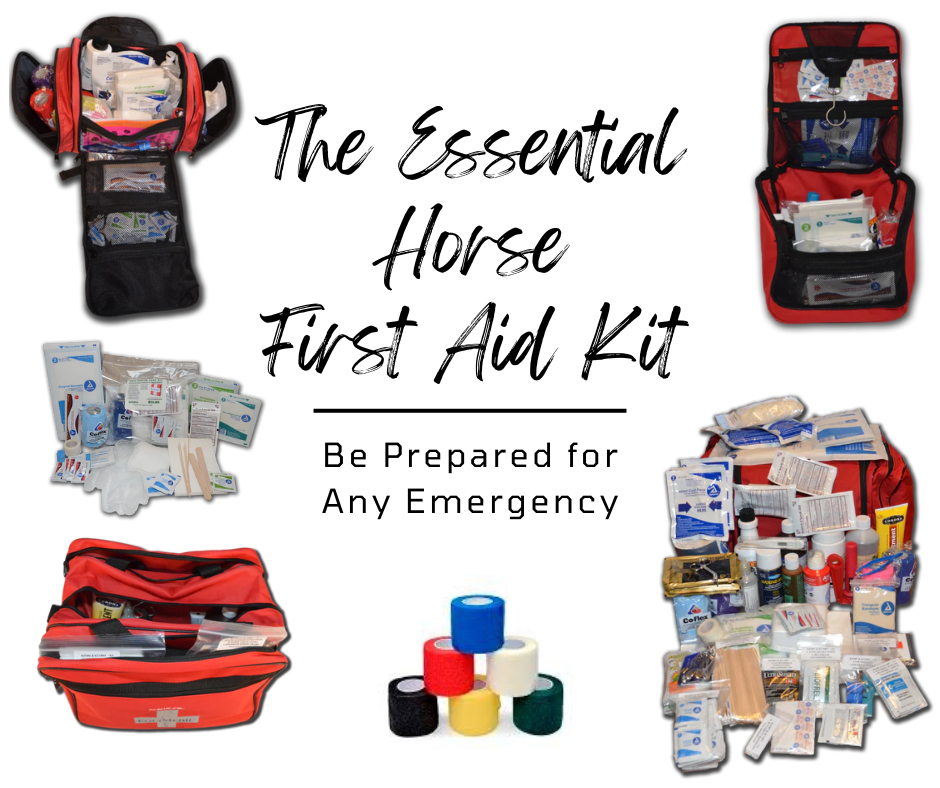
The Essential Horse First Aid Kit: Be Prepared for Any Emergency
Share
As a horse owner, it's crucial to be prepared for any emergency that may arise while caring for your equine companion. Having a well-stocked first aid kit specifically tailored for horses can make all the difference in managing injuries or health issues promptly and effectively. This blog post will guide you through the essential items you need to include in your horse's first aid kit, ensuring you're always ready to provide the best care for your horse, whether at home or on the road. Use each section as a checklist for your own vet kit, or if you don’t want to put one together yourself, Equimedic has a great variety of pre-made vet kits ready made for you!

Basic Tools
A comprehensive first aid kit starts with basic tools that can be used in various situations. Essential items include a knife, hoof pick, scissors, fly spray, flashlight, farrier tools, latex gloves, paper towels, hand sanitizer, screwdriver, pliers, and wire cutters. Additionally, having bailing twine or wire can be incredibly useful. While any scissors can be handy, bandage scissors are specifically designed for safety, making them a preferred choice around injured and nervous horses. A digital thermometer and stethoscope are also necessary, they are invaluable for monitoring your horse's health.
Ensure your kit includes the following:
- Knife
- Hoof pick
- Scissors (preferably bandage scissors)
- Fly spray
- Flashlight
- Farrier tools
- Latex or non-latex gloves
- Paper towels
- Hand sanitizer
- Screwdriver
- Pliers and wire cutters
- Bailing twine or wire
- Digital thermometer
- Stethoscope

Wound Cleansing & Dressing
For wound cleansing and dressing, your kit should include saline solution, Betadine solution, triple antibiotic ointment, and aluminum spray. A hemostatic agent like Curicyn’s Blood Stop Powder is also essential for treating profusely bleeding wounds or cut arteries. Saline solution can be substituted with contact lens saline solution if needed, and it can provide added pressure for cleansing wounds. Betadine solution, not scrub, is ideal for first aid kits since it is safe for use on open wounds. Triple antibiotic ointments like Neosporin are effective for treating wounds. Aluminum spray, often referred to as "scab in a can," is great for treating superficial wounds.
For effective wound care, your kit should contain items for cleansing and dressing wounds:
- Saline solution (or contact lens saline solution)
- Betadine solution (not scrub)
- Antimicrobial spray or gel
- Aluminum spray (also known as "scab in a can")
- Hemostatic agent (Blood Stop Powder)

Bandage Materials
Your first aid kit should include a variety of bandage materials such as gauze pads, Telfa or non-stick pads, roll gauze, Vetrap, cotton combine, Elastikon, and duct tape. Larger Telfa pads are versatile and can be cut to size as needed. Cotton combine, preferred over rolled cotton, maintains its form better and is easier to wrap, making it an excellent choice for pressure or support bandages. Roll gauze is indispensable for creating smooth bandages. It's also a good idea to have some diapers in your kit for hoof wrapping!
Your first aid kit should be equipped with various bandage materials to handle different types of wounds and injuries:
- Gauze pads
- Telfa or non-stick pads (larger sizes preferred)
- Roll gauze
- Vet wrap (or similar self-adhesive wrap)
- Cotton combine
- Elastikon
- Duct tape
- Diapers

Drugs & Medications
Your kit may also contain both oral and injectable medications. Injectable medications act quickly but require knowledge and comfort with administering injections. Pain relievers like Bute, Banamine, and Equioxx are essential, each serving different purposes. Bute and Equioxx are ideal for musculoskeletal pain, while Banamine is effective for visceral pain such as colic. Ensure you check expiration dates regularly and consult with your veterinarian about proper dosages and administration. Common drugs such as Bute and Banamine come in various forms that make them easy to use, especially if you are uncomfortable with injections. For sedation, oral Dormosedan gel and Acepromazine are options, though they require time to take effect. Keep a range of syringes and needles to administer these medications correctly.
It's important to have a selection of medications and the means to administer them. Consult your veterinarian for prescription medications. Include the following in your kit:
- Phenylbutazone (Bute) - paste or injectable form
- Banamine - paste or injectable form
- Equioxx - paste or injectable form
- Oral Dormosedan gel (for sedation)
- Acepromazine (oral form for sedation)
- Syringes (12 cc for pain relievers, 3 cc for sedatives)
- Needles (1-inch for intravenous, 1.5-inch for intramuscular)

Be Prepared for the Unexpected
It's always wise to be prepared for the unexpected! The rodeo road is full of unpredictable situations, so having essential pharmaceuticals and the means to administer them is crucial. Familiarize yourself with how to give different types of injections and the specific use of medications in your kit, and always keep your veterinarian's contact information handy for emergencies.
Being prepared for unexpected events is crucial. In addition to the items listed above, consider adding the following to your kit:
- Dexamethasone (for allergic reactions)
- Syringes (3 ml, 12 ml, 35 ml, 60 ml)
- Needles (18G x 1½” and 20G x 1½”)
- Sterile saline solution
- Nitrofurazone dressing
- Eye ointment
- Sulfamethoxazole trimethoprim (SMZ) tablets
- Latex or non-latex gloves

If all of this sounds a little too overwhelming, and you'd rather just buy a ready made vet kit - Equimedic has you covered! Check out the various sizes available on our website. We're sure they will have a size that fits your needs!




Having a well-prepared first aid kit for your horse is a vital part of responsible horse ownership. By equipping yourself with the necessary tools, wound care supplies, bandage materials, and medications, you can effectively manage emergencies and provide immediate care to your horse. Regularly review and update your first aid kit to ensure all items are in good condition and within their expiration dates. Consult with your veterinarian to ensure you have the right supplies and knowledge to handle any situation that may arise. Being prepared can make all the difference in your horse's health and recovery during an emergency!
